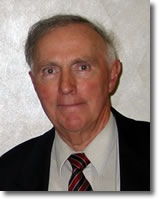Mulligan's Professional Training Courses

Mulligan's Professional Courses
Brian Mulligan is the creator of the Mobilisation With Movement" (MWM) as we know it today. MWM examination and treatment techniques integrate manual therapy, functional exercise, and cognitive therapy elements.
These two-day practical workshops provide clinical reasoning strategies and detailed hands-on instruction on unique examination and treatment techniques.
MWM is one of the most popular approaches physiotherapists use to treat neuromusculoskeletal conditions. Mark has presented Mulligan courses for over 30 years and assisted Brian worldwide on numerous occasions. The approach is easy to learn and integrate into existing examination and treatment models. There is a large body of research validating the concept.
Brian's textbook is now in the 7th edition. There are two comprehensive books by eminent physiotherapy researchers detailing the theory, principles, concepts, and relevant research relating to the evidence-based practice of MWM (Vicenzino et al 2011, Hing et al 2020). 
Course Goals
- • To present the principles of the Mulligan Concept
- • To demonstrate clinical applications of these principles
- • To explain the clinical reasoning process of the Mulligan Concept
- • To develop and refine manual skills
- • To offer theoretical models to explain the clinical results achieved
- • To challenge some ways that established conceptual models of pathology and biomechanics are used to justify and determine treatment approaches
- • To demonstrate how MWM principles can be integrated into established treatment regimes
- • To outline current research & publications related to the Mulligan concept
- • To present information in an open non-threatening collegial dialogue
- • To provide participants with a stimulating learning experience.
 Mark Oliver presents the Mulligan Upper and Lower Quadrant courses in Perth and also his own courses "SIJ & Pelvis" and "TMJ & Orofacial Pain" in which assessment and treatment methods are based upon Mulligan concepts.
Mark Oliver presents the Mulligan Upper and Lower Quadrant courses in Perth and also his own courses "SIJ & Pelvis" and "TMJ & Orofacial Pain" in which assessment and treatment methods are based upon Mulligan concepts.
Mark is an internationally recognised clinical educator with 30 years of clinical experience and 25 years of teaching experience. He was a lecturer on the Graduate Diploma in Manipulative Therapy and Graduate Diploma in Sports Physiotherapy courses at Curtin University has presented more than 200 clinical workshops and lectures, is a keynote speaker at conferences, and has written chapters in textbooks and published in scientific journals. Mark is Australia’s most experienced Mulligan Concept teacher and practitioner.
Orofacial/TMJ 1 Event
Presented by Mr. Mark Oliver (certified Mulligan concepts teacher), this 2-day practical workshop provides participants with new examination and treatment skills for orofacial pain and temporomandibular dysfunction (TMD) based on the Mulligan Concept of mobilisation with movement. Mobilisation with movement is one of the most popular approaches physiotherapists use to treat neuromusculoskeletal conditions. Mark has presented Mulligan courses for over 30 years and assisted Brian Mulligan worldwide on numerous occasions. The approach is easy to learn and integrate into existing examination and treatment models. A substantial body of research supports the concept.
Appropriately trained physical therapists can significantly contribute to the management of temporomandibular joint disorders (TMD). This two-day practical workshop is an advanced course for clinicians (physical therapists, osteopaths, chiropractors, medical practitioners) who have completed a basic Mulligan course.
A health professional working in the field of orofacial pain must have a sound knowledge of temporomandibular joint (TMJ) and orofacial anatomy, relevant neurophysiology, pain neuroscience and the contribution of spinal dysfunction to TMD. They must also be able to perform a detailed clinical examination and develop an effective treatment plan within a biopsychosocial context. Physical therapists treating orofacial pain and TMD must have a sound appreciation of dental management and fit into a multi-disciplinary treatment team.
Physical therapists can expand their knowledge of anatomy, biomechanics, neurophysiology and pathology using e-learning or books. Still, the in-person course is the most effective way to grasp clinical reasoning concepts and master “hands-on” skills. This course will equip participants with the necessary knowledge and skills to perform accurate, precise TMJ evaluation and treatment.
Participants will learn original TMJ MWM techniques developed by the presenter to treat:
- Acute malocclusion
- Retrodiscal pain
- Loss of mobility due to internal derangement, degenerative change, intra-articular adhesions
- Restoration of function following orofacial surgery
- Altered neuromotor activity.

"Just passing on some feedback about the Mulligan's Orofacial/TMJ course - it was well worth the wait.
Mark is a fabulous presenter with the patience of a saint. His means of conveying the material made it easy to take in and understand. The catering was also excellent."
SueLin Kalisch - Physiotherapist
Learning Outcomes
On completion of this course, participants should;
• Have a good understanding of the applied anatomy of the orofacial bony, ligamentous and neuromuscular systems as they relate to the TMJ
• Have an appreciation of relevant neuroscience and pain neuroscience relating to the TMJ and orofacial region
• Have an understanding of the etiology of TMJ neuromusculoskeletal disorders
• Have a good understanding of how whole-body function and posture can contribute to TMJ dysfunction
• Be aware of the current literature related to physical examination and treatment of the TMJ (up-to-date reference list provided)
• Have a good understanding of the Mulligan concept of MWM and its clinical reasoning process
• Be able to confidently perform a basic evaluation of the TMJ and related orofacial musculature
• Be able to perform basic TMJ MWW and self–MWM treatment techniques
• Be able to design and implement individualised neuromuscular exercise and “brain game” programs for the TMJ and, when indicated, integrate them into a whole-body exercise program
• Have an appreciation of how physical therapists should fit into a multi-disciplinary team treating TMD
• Be aware of other relevant forms of treatment for orofacial pain and dysfunction in a biopsychosocial context.
Course Content
- Introduction and the biopsychosocial multi-disciplinary team approach to TMD
- Functional anatomy of the TMJ and orofacial region
- Neurophysiology of the TMJ and orofacial pain
- Etiology and pathology of TMJ disorders
- The influence of the spinal column on TMD (biomechanical)
- Identification and treatment of causative factors
- Examination of TMJ and related orofacial structures
- Treatment of specific TMJ disorders using MWM
- Associated orofacial pain and dysfunction treatment techniques and strategies.
Resources
- Oliver M. 2011 Temporomandibular joint dysfunction. An open and shut case.
- Chapter 10 in Mobilisation with Movement: The Art and Science. Vicenzino B, Hing W, Rivett D & Hall T, Elsevier Publishing 123- 133.
- This chapter demonstrates the clinical reasoning process in the application of MWM for the TMJ and describes the application of some TMJ MWM techniques. An instruction DVD is also included.
- Oliver M & McDowell J 2019 Temporomandibular joint. Chapter 4 in The Mulligan Concept of Manual Therapy: A textbook of techniques. Hing W, Hall T & Mulligan B, Elsevier Publishing 87-101.
AAP Education Rural & Remote Scholarship
If you work in a designated rural and remote region, 4 - 7 using the Modified Monash model, you may select an AAP Education rural and remote position for this course. Places are provided on a first-come basis.
Rural & Remote Professional Development Support
See Rural Workforce Support Agencies for details in your state or territory.

